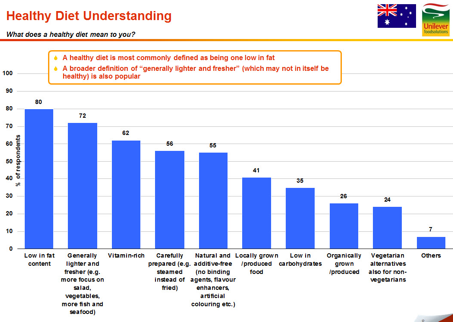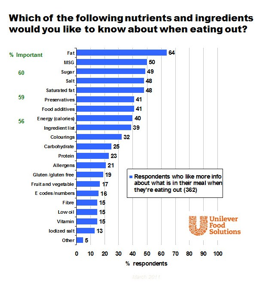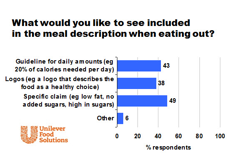Australians demand more when dining out
Written by Catherine Saxelby
on Thursday, 30 June 2011.
Tagged: drinks, eating out, fat, food trends, healthy cooking, healthy lifestyle

Over 70 per cent of Australians want to know more about what's in their meals when eating out, including nutrition and transparency of ingredients, according the a new survey entitled the "World Menu Report".
Eating out is a big part of our food lives these days. Busy people - like me - enjoy eating out because of its convenience, new taste experiences (so I can try dishes I wouldn’t normally attempt myself), and the chance to catch up with friends and family.
I was delighted to be part of the inaugural World Menu Report (WMR) which was commissioned by Unilever Food Solutions in nine countries. My job was to review the results and present the key findings. Here’s what caught my eye. These are my highlights from the survey, giving you a look at a growing trend in eating out in 2011.
Why we love to eat out
This study confirms what you’d expect. Eating out is about the experience and enjoyment – trying new tastes, the atmosphere, a nice break from routine, getting out of the house, catching up with family and friends, enjoying the company, not having to cook or clean up, feeling relaxed and having fun, no hassles. In other words, eating out means enjoyment! Not nutrition.
“Because if I am out for a meal I want to enjoy it and not worry too much.”
“I’m strict at home so want to enjoy the taste/experience of eating out.”
It also confirmed the negatives around eating out: bad service, disappointing food, cost, being unsure of the kitchen cleanliness, wondering about the ingredients used in the meal and how it was cooked, worrying about having a reaction to an allergen, and eating more than you should.
As I’ve said elsewhere, eating out is not always the best for nutrition for these reasons:
- We tend to eat more and drink more alcohol.
- We lower our expectations of nutrition – we’re happy to eat more fat, pastry, salt than we care to admit
- We don’t get enough vegetables and salad.
Lunch an undiscovered opportunity
According to the WMR, lunch is the meal most commonly eaten out – 80 per cent of respondents eat lunch out once a week or more. And a huge 29 per cent eat lunch out four times a week or more (that’s most days of the week). Virtually no-one never eats lunch out.
I found this surprising since very little attention is paid to lunch and its nutrition contribution. Nutritionists focus on breakfast (often called the most important meal of the day) and dinner gets our focus as it’s the one meal people think about and plan, seek recipes and shop for. But not lunch.
For cafes and restaurants, I think lunch is an undiscovered opportunity, especially in colder months when people are less likely to venture out at night.
A healthy diet still means “low-fat”!
I was dismayed to learn that 80 per cent of Aussies define a healthy diet as “low-fat”. After this, they nominated:
- 72% light and fresher
- 62% vitamin-rich
- 56% carefully prepared (steamed not fried)
- 55% natural and additives-free
- 41% locally-grown

Perhaps consumers hear talk of saturated fat, trans fat, fat-free, omega-3 fat, good fat and bad fat – but it’s all “fat” to them.
Given the popularity of the Mediterranean Diet and the interest in olive oil, low-fat runs contrary to both those trends. I believe it’s time to broaden our nutrition horizon. I prefer a more wholistic approach i.e. healthy eating embraces lighter/fresher, vitamin-rich, cooked well, natural/additive free. We nutritionists still have work to do!
In contrast, the term “healthy diet” meant different things in other countries. It meant “vitamin-rich” “(scored 93% for Germans) OR “natural and additive-free” (87% for Brazil).
These days, “healthy” also embraces “locally-grown” and organic. I regard these two as extraneous to “nutrition” but clearly people are thinking of them together. However something that’s “organic” does not always mean it’s “healthy” eg organic bacon can still have lots of bad fat, salt and pickling compounds.
Fat and MSG still top of mind
The WMR survey found that respondents were most interested in seeing fat (64%), followed by MSG (50%), and then sugar (49%), salt (48%) and saturated fat (48%) on their meals out.
They didn’t show the same interest in preservatives, additives, calories, ingredient lists, colours, carbohydrate, protein or gluten-free. I was puzzled that there was no mention of trans fat, GI or wholegrain.
Also no mention of kilojoules despite the recent State Government initiatives to introduce kilojoules and %DI into fast food menu boards.
Finally there wasn’t much chatter about food allergies/intolerances or special diets being listed as a barrier to dining out eg anyone with a peanut allergy (anaphylaxis) needs to be extremely careful about traces of peanuts in everything including peanut oil.

Best way to present the information
Presenting nutrition info on menus without heaps of numbers and tables is the key. I feel a simple “healthy choice” logo would be perfect for restaurants and 38 per cent of the respondents agree. Not every dish has to be labelled “healthy”. Flagging 4 or 5 dishes on the menu is all that’s needed. This is already being done on many in-room dining menus, airlines and some restaurants. For example:
- lower-fat
- healthy heart
- lower calorie/kilojoule or light
- vegetarian
- extra vegetables
- gluten-free or wheat-free
Diners want to know more

Given that 68 per cent believe they are more likely to make a healthier choice if they can see some nutrition information, it’s something that restaurants should start thinking about.
Cafes and restaurants are not required by law to display nutritional information in the same way that manufactured foods are, so it’s not surprising that 88 per cent of Australians did not see nutritional information the last time they ate out of home. Reasons given for wanting better fare include:
“We’re watching our health and weight”
“I like to make informed, intelligent choices”
“I’m trying to learn about healthier choices”
“Because we're in an obesity epidemic”
About the World Menu Report survey
The World Menu Report is a global snapshot of consumers eating out of home patterns. It polled 4,500 consumers online across nine countries – Australia, New Zealand, UK, USA, Germany, Brazil, Russia, China and Turkey.
The age range was from 18 to over 60 with 26 per cent in the 24-35 age range. Half were females, half males. The only inclusion criteria was that participants had to eat out at least once a week.
This is the inaugural World Menu Report commissioned by Unilever Food Solutions, a global supplier of ingredients to the food service and hospitality industry such as cafes, restaurants, sandwich shops, hotels, clubs, bars, schools, cafeterias, nursing homes and prisons. Unilever plans to repeat the survey again in six months.
Foodwatch
The Good Stuff
The Boring Stuff
© 2025 Foodwatch Australia. All rights reserved
Website by Joomstore eCommerce





